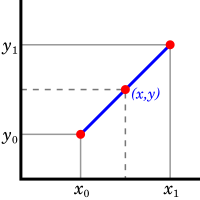Linear interpolation

Okay kiddo, let me break it down for you. Imagine you have two points on a graph with a line connecting them. If you want to know what point is halfway between those two points, you can use linear interpolation.
Linear interpolation is like drawing a straight line between two points and then finding a point along that line. It’s like connecting the dots!
For example, let's say you have a graph with two points labeled "A" and "B." Point "A" is at the bottom left corner and point "B" is at the top right. You want to find the point halfway between "A" and "B".
First, you would draw a straight line from "A" to "B" on the graph. Then you would split that line in half, creating a point in the middle. This new point is your interpolated point, and it’s located exactly halfway between "A" and "B" on the line.
Linear interpolation is a fancy way of saying that you can estimate the value of something at a certain point by connecting the dots and filling in the gaps. It's really useful in math, science, and all sorts of other areas where we need to make educated guesses based on the information we have.
Linear interpolation is like drawing a straight line between two points and then finding a point along that line. It’s like connecting the dots!
For example, let's say you have a graph with two points labeled "A" and "B." Point "A" is at the bottom left corner and point "B" is at the top right. You want to find the point halfway between "A" and "B".
First, you would draw a straight line from "A" to "B" on the graph. Then you would split that line in half, creating a point in the middle. This new point is your interpolated point, and it’s located exactly halfway between "A" and "B" on the line.
Linear interpolation is a fancy way of saying that you can estimate the value of something at a certain point by connecting the dots and filling in the gaps. It's really useful in math, science, and all sorts of other areas where we need to make educated guesses based on the information we have.
Related topics others have asked about:
